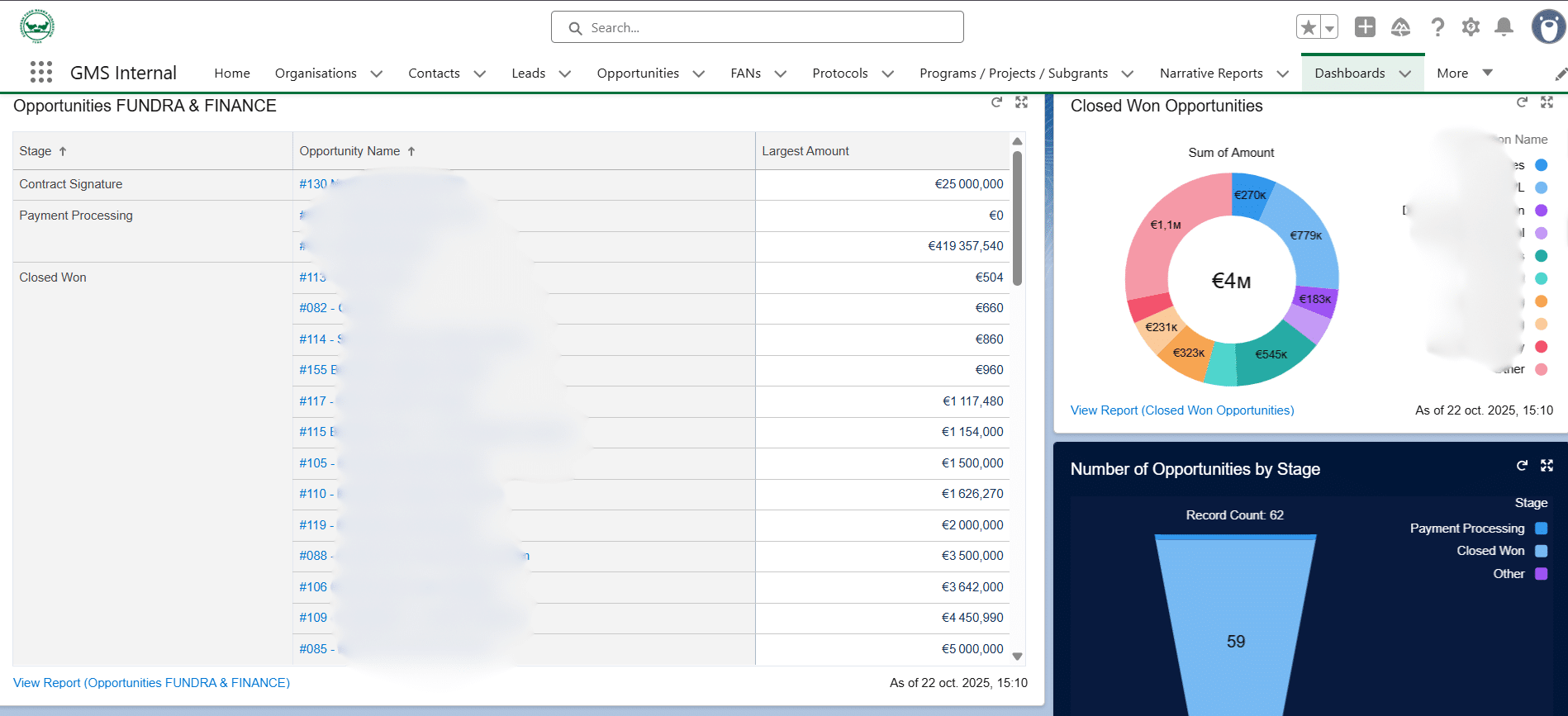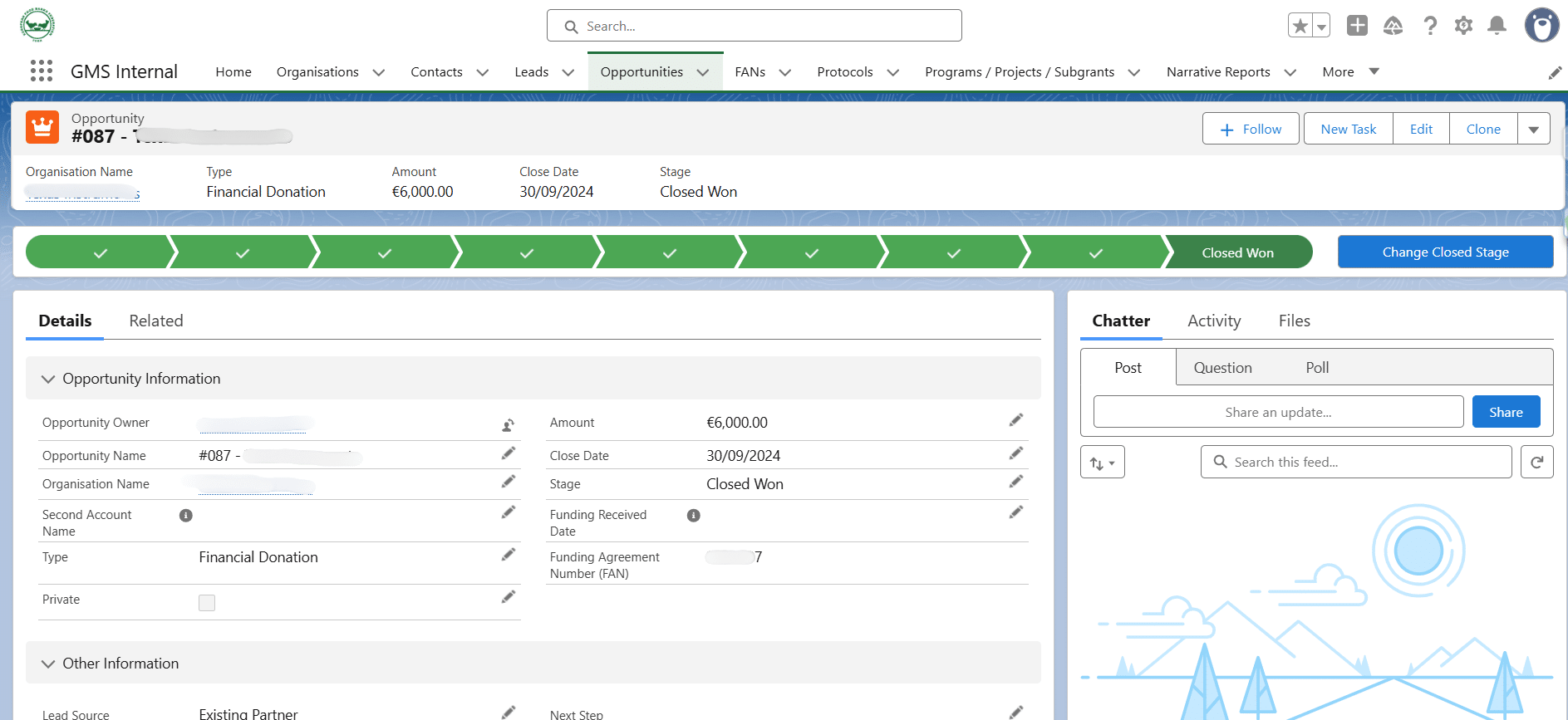Case Study
FEBA

- Market segment: Nonprofit, NGO
- Thematic Area: Zero hunger, Good Health and Well-being
- Region: Europe
- Project Type: Quickstart Fundraising, Grant Management, Managed Services
- Solution used: Salesforce NPC for Fundraising
Established in 1986 and based in Brussels, the European Food Banks Federation (FEBA) is a European nonprofit membership organization working in collaboration with a network of Full and Associate Food Bank Members in 30 European countries.
The daily activity of FEBA Members consists of recovering, collecting, and redistributing food to charities assisting the most deprived in Europe.
In 2024, the 351 Food Banks belonging to FEBA’s members redistributed 834,000 tonnes of food to 43,345 charitable organizations providing food assistance to 12.2 million most deprived people, thanks to the professionalism of 109,181, of which 92% are volunteers.

The Start of Our Journey Together
We partnered with the European Food Banks Federation (FEBA) initially to modernize their data management and help them centralize fragmented donation information. Our first project in 2024, a QuickStart for Fundraising implementation, used Salesforce Nonprofit Cloud to replace manual processes, streamlining their donor management and reporting.
This success paved the way for a deeper engagement in 2025, introducing Amp Impact for inbound grants and project management and further optimizing FEBA’s ability to manage both incoming and outgoing commitments.
Following the successful implementation of Amp Impact, we transitioned into Managed Services and developed a long-term roadmap to ensure continuous system improvement. This roadmap includes plans to enhance FEBA’s financial, marketing, and event management systems over time.
“The Vera scoping and implementation team was a pleasure to work with. From understanding our complicated financial processes to weaving them into our ways of working with the tool was a seamless experience. The team really took the time to get to know us, and it truly felt like they were an extension of our team.”
– Suzanne Zudiker, Head of Strategic Partnerships and Fundraising.
Fundraising QuickStart (2024)
FEBA faced the challenge of managing donation data from various organizations and members. Staff and administrators needed to manually record and report information about new donation opportunities, pledges, and payments, which were tracked across several spreadsheets. The lack of a centralized place to manage all stakeholder and donor data–from initial identification to closing and renewing of future collaborations–led to inefficiencies in redistributing donations to members. Without a framework to nurture, develop, and track funding opportunities, FEBA sought services for the selection, implementation, and deployment of a CRM and fundraising solution. FEBA hoped to migrate 5,000 contact records into the CRM system at launch, with the goal of continuous expansion in the future.
FEBA partnered with Vera Solutions to implement a QuickStart for Fundraising solution leveraging the native Salesforce Nonprofit Cloud capabilities. This QuickStart allowed FEBA to perform institutional and individual donor management, comprehensive gift tracking, and reporting, aligning with industry best practices cost-effectively.

During six weeks, the project began with a kickoff session to define system requirements and key success factors. Nonprofit Cloud for Fundraising (NPCF) was then configured, which involved editing labels, updating picklist values, and creating a “relabelling map” to ensure consistency.
By addressing FEBA’s stakeholder management, project management, and data visualization requirements, Vera’s NPCF QuickStart project empowered stakeholders and administrators to adopt and leverage the system through a comprehensive set of resources, including facilitated training, user guides, demos, recordings, and data migration templates.
After migrating its fundraising data from spreadsheets onto Salesforce NPCF, FEBA now saves valuable time through streamlined data processes and has gained better visibility through user-friendly Reports and Dashboards. FEBA can now efficiently track fundraising opportunities, manage donor commitments, and monitor transactions, improving overall data management.
“We are deeply appreciative of Vera Solutions for their dedication and hard work—this CRM system has truly transformed how we operate. Transitioning from spreadsheets to Salesforce has been a significant change, and we have gained valuable insights along the way. Vera’s responsiveness and support have been invaluable, and we look forward to the new opportunities this technology will enable for our future.”
– Suzanne Zudiker, Head of Strategic Partnerships and Fundraising.
Amp Impact for Grants Management (2025)
In Phase 2 of its system improvements, FEBA expanded its Salesforce usage beyond fundraising to include a comprehensive grants management and project management solution, leveraging out-of-the-box Amp Impact functionalities. Given its reliance on grants and external donations, FEBA sought to simplify the complex process of managing incoming grants and outgoing sub-grants for its internal team and sub-grantees. The project’s ultimate goal was to grow and diversify revenue streams by improving the tracking of donor attrition and retention and strengthening relationship management. The implementation also included adapting three custom flows and categorizing organizations for reporting, aligned to FEBA’s funding portfolio.
The system’s architecture includes a hierarchical structure of Programs, Projects, and Subgrants, enabling detailed financial tracking and the calculation of funding gaps. We used the Declarative Lookup Rollup Summaries (DLRS) tool to roll up financial data from subgrants to projects and programs, which was crucial for comprehensive reporting. For fund and allocation management, we introduced Funding Agreement Number records, which serve as the central point for allocating funds to specific projects or subgrants via Disbursements.
The system also includes an Experience Cloud portal for subgrantees, enabling them to view their grants, reporting periods, and financial transactions. Subgrantees can submit both qualitative and financial reports through the portal, using Narrative Reports (Amp Impact Submissions) and a Amp Impact’s budget/expenditure upload feature. Internally, the platform supports a wide range of project management functions, including work plans, activities, and a risk register. All data is managed within Salesforce, with built-in reports and dashboards providing insights into the entire funding hierarchy, although the final consolidation of reports for donors is currently handled outside the system.
The Amp Impact grant management solution for FEBA was delivered through two phases: (a) Discovery, Design, & Prototype Configuration and (b) Implementation of Priority Functionality. The first phase (8 weeks) focused on defining requirements, designing a declarative system, and prototyping core Amp Impact features like fund allocation to match FEBA’s requirements. This included workshops, initial prototype configuration, and an implementation plan. Some features that were prototyped included Opportunities to generate Funding Agreement Numbers for fund distribution, with DLRS installed for architectural support.
The Implementation of Priority Functionality phase (12 weeks) involved configuring Amp Impact’s Programs, Projects, and Subgrants hierarchy, building on features like Work Plans, Activities, Risk Registers, and Modifications. A dedicated Experience Cloud portal was set up for subgrantees to submit Narrative Reports (Amp Submissions with flexible, lockable templates) and financial reports via Amp Impact budget templates. DLRS was used to aggregate financial data from subgrants to projects and programs for funding gap analysis. This phase concluded with User Acceptance Testing, production deployment, comprehensive training, and documentation. Other key elements included user provisioning, notifications, and a security model.
FEBA now has a system in place to manage both donations from funders and sub-grants to sub-grantees (‘members’). Their new system centralizes financial and operational information, streamlines donor and grant management, and provides effective email reminders for reporting. The system is flexible to ensure the FEBA team can access and edit each other’s records as well as manage permissions for and access to particular objects and applications. Vera collaborated with FEBA throughout the implementation to ensure the project remained on budget, finding time-saving efficiencies when new requirements challenged the scope. The mutual confidence established during the project set the stage for a good working relationship for future growth.

Managed Services (2025 & Beyond)
Following system go-live, Vera and FEBA transitioned into Managed Services to ensure a smooth continuation of support. Vera continues to support FEBA by addressing system questions that come up and a backlog of enhancement requests. Recent work has included training on report building, portal UI updates, and revising account page layouts.
The system roadmap outlines plans for continued expansion and enhancement of existing capabilities. One key piece of future development will be integration with the organization’s accounting platform to improve financial data management and operational efficiency. Additional functionality, such as marketing and event management modules, will be explored to support broader business objectives, including customer engagement and campaign execution.
